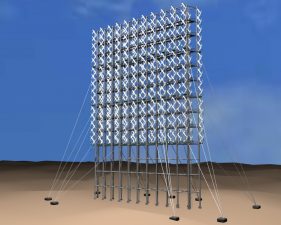NASDAQ-traded Ormat Technologies (ORA) is involved in the proposed construction of a giant geo-thermal electric power plant in Indonesia, a country that is now in bad need of more electric power, even though it is a member of the Organization of the Petroleum Exporting Countries (OPEC).
The project is estimated to cost around $800 million, and has been in the works since 2006, when a contract was awarded to a consortium of companies headed by PT Medco Energi Internasional (MEDC.Jk), and including the Japanese company Itochu Corporation.
The plan is to have Ormat, whose geo-thermal energy collection installations can be found around the world, tap into the raw energy of Indonesia’s hot springs and magma fissures. One small problem – there is a chance that Ormat’s technology might cause a volcano eruption.
In a meeting with news reporters, Indonesia’s Energy J. Purwono, said that his country “badly needs more power plants.”We need this project to be built quickly because it is very important for Indonesia.”
Indonesia is the world’s largest Muslim country. It has large, untapped geothermal energy potential do to numerous volcanoes and hot springs which can provide the energy to run the 330 megawatt geothermal plant in Sarulla, North Sumatra. Indonesia is estimated to have geothermal potential to produce 27,000 mgw of electricity.
It is unusual that Indonesia, which has no diplomatic relations with Israel is willing to do business with Ormat.
Ormat Industries is one of the world’s leading vertically integrated companies dedicated to providing solutions for geothermal power, recovered energy generation (REG) and remote power. Geothermal energy is an excellent alternative energy source that is both clean and non-polluting.
Ormat Energy Converters (OEC), are Closed Cycle Vapor Turbogenerators (CCVT) with capacities ranging between 200 and 4500 Watt for unattended operation.
There is some risk in trying to “tap” the energy potential of these hot springs and molten magma fissures, due to the possibility of their becoming active volcanoes. For this reason, using this power source is generally more expensive than other energy sources, including petroleum and natural gas. But the advantages are surely worth the costs.
In other news Ormat unwinds its biodiesel activities with Evogene and the faltering Lev Leviev in Africa. In Guatemala, the company has refinanced a $43 million geothermal project.
::Ormat Technologies website
::Reuters
[image via isa adsr]




I feel that is among the such a lot important info for me. And i am glad reading your article. However wanna commentary on few normal things, The web site style is great, the articles is in reality excellent : D. Good activity, cheers
The ticker symbol for Ormat is NYSE:ORA, not NASDAQ:ORO. You can read more about Ormat’s international projects and Indonesia’s geothermal energy efforts here:
http://www.greenchipstocks.com/articles/geothermal-energy-indonesia/401
I definitely agree that the advantages are worth the cost. Thank you for sharing the info.
The effects described by Karin are typically associated with Dry Hot Rock technology where rock has to be fractured (by explosives)to become permeable for water; this is typical for European (deep drill) sites (expensive too by the way); in Indonesia for instance the depth to drill is much less and there are a few earthquakes every day even without the drilling , this should not make us reject an otherwise clean form of energy. I understand however, that people are concerned if there is no proper communication.
In the real world, there are simply a few choices about power generation to make, but none of it has no side effects; in my opinion, geothermal has far fewer side effects than many other technological options which will still be needed in other areas of the world which are less lucky than Indonesia or Philippinesin terms of geothermal ressources.
Yeah Mitch,
The volcano thing is relavent if it happens where YOU ARE!
I’m a geoscientist with 30 years in the geothermal industry, and this article was forwarded to me. It has several small errors, but also contains a major fallacy, the statement that “Ormat’s technology might cause a volcano eruption.” Geothermal power plants have been developed at dozens of volcanic sites around the globe, with thousands of wells drilled. There was one geothermal well in Iceland that became a conduit for a tiny, harmless flow of volcanic scoria. Other than that, I am not aware of any problems of this nature. In the Sarulla area, the volcanoes are not active. There are certainly environmental and cost issues associated with geothermal energy development, but the threat of causing a volcanic eruption is not even a minor concern.